QuestionI HAVE A 8TH MONTH OLD TOY PUDDLE WHICH IAM HAVING TROUBLE TRAINING FOR OUTSIDE OR INSIDE FOR THE BATHROOM...
ALSO I CANT FIND HER A PUPPIE FOOD THAT SHE LIKES, SHE ONLY EAT THE FOOD WHEN SHE IS VERY HUNGRY..
ALSO SHE IS AND HEAT REAL BAD AND SHES ONLY 8 MONTHS WHAT SHOULD I DO...
AnswerThe second and third weeks are when the most risk of accidental breeding is. Don't take this lightly. She will do anything to get loose and get to a male. Once loose, an accidental breeding and an unwanted litter is far from the worst that can happen. Such breedings can also result in fatal infections. She can get killed when she dashes heedlessly across the road in front of a car. Other dogs or coyotes may kill her.
You can expect the same thing about every 6 months for the rest of her life if you don't go ahead and get her spayed. There is no other answer, and no good reason not to. Besides saving the hassles, it reduces the chances of cancer later in life. Please make life easier for yourself, her, and society in general by getting her spayed as soon as a vet will do it.
If the dog never did eat very well, and has seen the vet since the problem existed, you may be over feeding it. A vet check still won't hurt. Many dogs will snarf down more than is good for them and look for more. Others refuse to eat more than than they need. Evaluate the dog as illustrated in this link, http://www.longliveyourdog.com/twoplus/RateYourDog.aspx You may want the vet to confirm your judgment. Adjust the dogs food and exercise as needed to reach its ideal body condition. Some German Shepherds and other breeds may refuse to eat enough to completely hid their ribs. As long as you are feeding a concentrated, meat based chow, the best thing is to accept it.
The worst thing you can do is to bribe a dog with rich foods into eating more than it needs. Instead, Put down the dish with what the dog should eat, and give it 15 minutes to eat. Then take it up. Do not give it anything to eat until its next scheduled meal. In a few days, it should be eating what it needs. Continue to check its ribs and adjust the food as needed. This is not easy. I had a Shepherd go 3 days on a few nibbles. I was a wreck, but she was fine. It is almost unknown for a healthy dog not to eat what it needs. Unfortunately, in too many cases, it is less than the package says, and less than the owner thinks the dog should have. Many dogs are quite good at holding out for tastier chow. Like kids, sometimes it calls for tough love.
Much of housebreaking is not training the puppy, but making it easier for your puppy, you, and your carpet while its body to catches up to its instincts. At around 8 weeks when the puppy goes to its new home, the time from when it realizes it has to go, and when it can't wait any longer is a matter of seconds. Only time will fix that. You can hardly be expected to be attentive enough to avoid all accidents. There is no sense punishing the puppy for your inattention. It is not fair to punish you either, but you still have to clean it up if you didn't have the puppy outside in time.
Housebreaking starts before you get home with the new puppy. If you don't have a crate, buy one. I prefer the more enclosed, den like plastic ones. Skip the bedding. At first it gets wet, and later it can be chewed into choking hazards. A wire grid in the bottom will help keep the puppy up out of accidents at first. They are available with the crates, but expensive and hard to find. A piece of closely spaced wire closet shelving from a home supply place is cheaper. I am now using a plastic vegetable bin with plenty of holes drilled in the bottom. It helps block off part of the crate for the smaller puppy. If you already have a metal crate, covering it may help. Just make sure you use something the puppy can't pull in and chew. Dogs that start out in crates as little puppies, accept them very well. Never leave an unattended puppy loose in the house. If nobody can watch it, put it in the crate. I suggest letting the dog have its crate all its life. A crate needs to be just big enough for a dog to stretch out in.
Choose a command and spot you want it to use. The less accessible to strays, the less chance of serious disease. If it is a female, choosing a non grassy spot will avoid brown spots later. When you bring it home, take it to the spot and give it the command in a firm, but friendly voice. Keep repeating the command and let the puppy sniff around. If it does anything, praise it. Really let it know what a good dog it is and how much you love it, and maybe a treat. Note, being out there not only means you can praise it, but it also keeps it from being snatched by a hawk. If it doesn't go, take it inside and give it a drink and any meals scheduled. A young puppy will need to go out immediately afterward. Go to the spot and follow the above routine. Praising it if it goes is extremely important. If it doesn't go, take it back inside and put it in its crate and try again soon. Do not let it loose in the house until it does go.
At first it is your responsibility to know and take the puppy out when it needs to go. It needs to go out the first thing in the morning, after eating, drinking, and sleeping. If it quits playing, and starts running around sniffing, it is looking for a place to go. Take it out quickly. You will just have to be what I call puppy broke until it is a little older. How successful you are depends on how attentive you are.
By the time most dogs are about 3 months old, they have figured out that if they go to the door and stand, you will let them out. The praise slowly shifts to going to the door. Some people hang a bell there for the dog to paw. If your dog doesn't figure this out, try praising it and putting it out if it even gets near the door. When you catch it in the act, give it a sharp ''Ah, ah, ah!'' and take it out. Clean up accidents promptly. I mostly keep the little puppies out of the carpeted rooms. Still I need the can of carpet foam sometimes. First blot up all the urine you can with a dry towel. Keep moving it and stepping on it until a fresh area stays dry. A couple big putty knives work well on bowel movements. Just slide one under it while holding it with the other. This gets it up with a minimum of pushing it down into the carpet. This works with even relatively soft ones, vomit, dirt from over turned house plants, or anything else from solids to thick liquids. Finish up with a good shot of carpet foam. Note, do not let the puppy lick up the carpet foam. Once the dog is reliably housebroken, your carpet may need a good steam cleaning.
Many people strongly strongly push cleaning up all evidence of past accidents. I am slower to suggest that. Dogs will return to the same spot if they can find it. When you see one sniffing the spot, that is your clue to run it out.

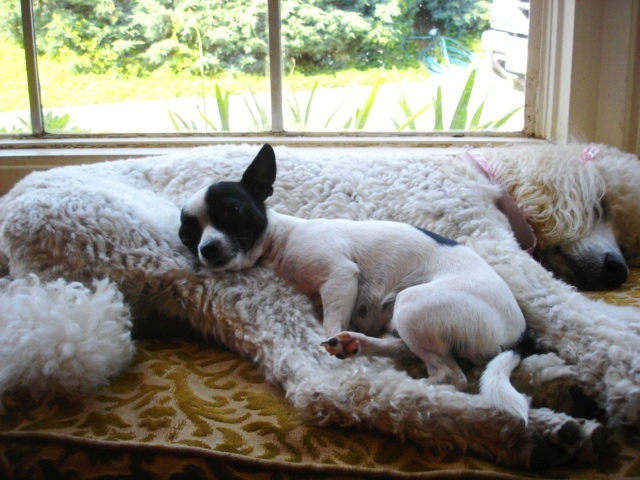 Another question about my standard poodle
QuestionIvory the Standard and
QUESTION: After o
Another question about my standard poodle
QuestionIvory the Standard and
QUESTION: After o
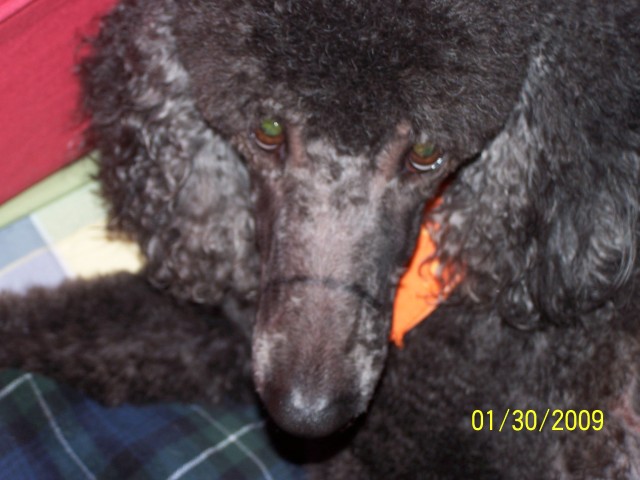 Stripe on nose
QuestionStripe on Perrys nose
QUESTION: Hello Ki
Stripe on nose
QuestionStripe on Perrys nose
QUESTION: Hello Ki
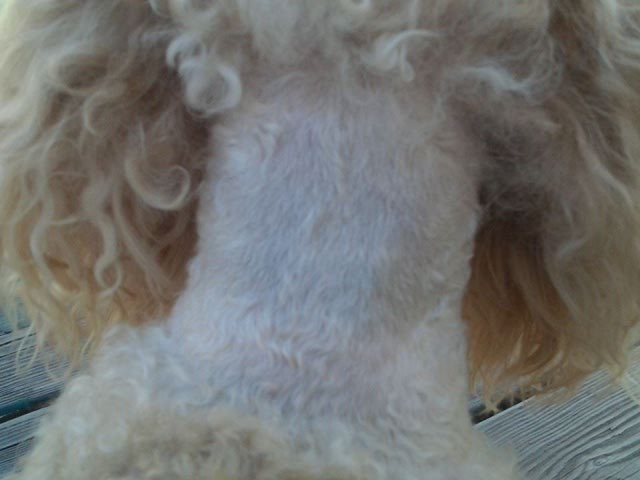 Bruising coloration
QuestionQUESTION: Hi...I have a 5 yr old male Toy Poodl
Bruising coloration
QuestionQUESTION: Hi...I have a 5 yr old male Toy Poodl
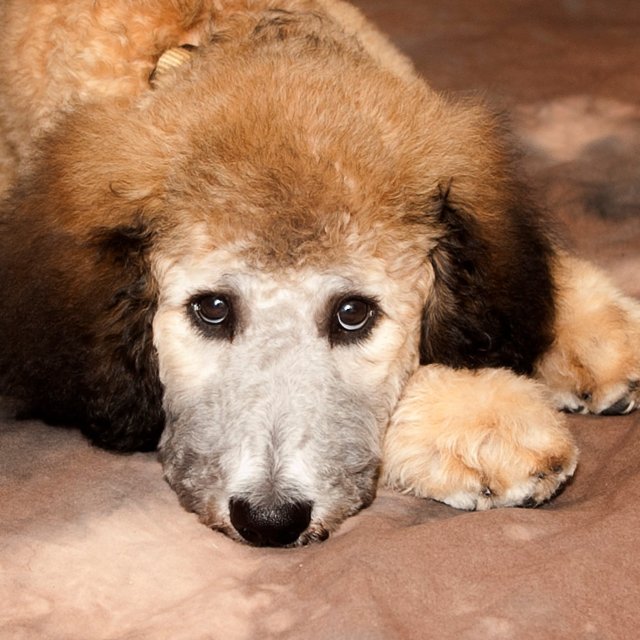 Poodle Coloring
Question
Ssouri
My boy Ssouri is 12 weeks old now. &nbs
Poodle Coloring
Question
Ssouri
My boy Ssouri is 12 weeks old now. &nbs
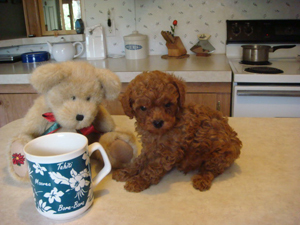 Fading
Question
red maltipoo
Hi, Im going to be getting a dark
Fading
Question
red maltipoo
Hi, Im going to be getting a dark